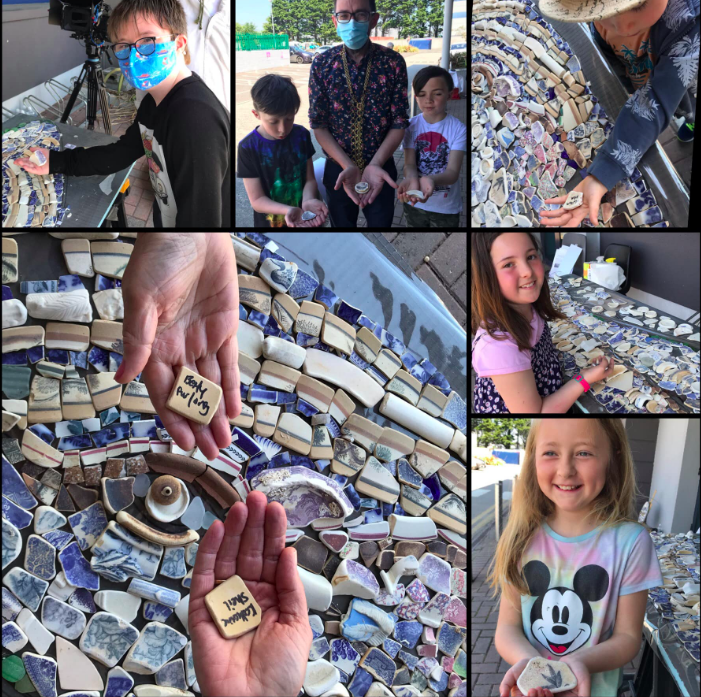Spotlight on Wexford Blue Whale
What links a blue whale beached in Wexford in 1891, 18th Century shipwrecks, pottery fragments washing ashore in Rosslare for more than 150 years and the Natural History Museum in London?
The stunning 5.2-metre-long blue whale skeleton suspended from the ceiling at the Natural History Museum in London. Beached in Wexford in 1891, it was sold for £250, and has been the centrepiece of the museum’s entrance hall since 2017. The whale has been named Hope, as a symbol of humanity’s power to shape a sustainable future.
On the morning of 25 March 1891, a blue whale, migrating up the east coast of Ireland, was caught by low tide and remained stranded on a sandbar just outside the harbour town of Wexford.
The whale was 15 years old and not fully grown, and, as you’d expect, locals took huge interest in this extraordinary occurrence. Local fisherman Ned Wickham, coxswain of the Wexford Lifeboat based at Rosslare Point, set out to investigate the stranded creature who was suffocating under her own weight as the tide ebbed. In an act of mercy, or perhaps enterprise, he plunged an improvised harpoon under one of the flippers to put the dying animal out of her agony.
The blue whale beached at Wexford Harbour in 1891.
The whale skeleton was kept in storage for over 40 years at the Natural History Museum, London, until the museum opened its new Whale Hall in 1938, the first blue whales to be put on display anywhere in the world.
Photo Credit: Natural History Museum, London
A newspaper clipping from 1891, reporting on the whale beaches in Rosslare; the same whale now displayed in the Natural History Museum London and the inspiration for Wexford Blue Whale by Helen McLean
So, what about the shipwreck?
Since 1854, pottery fragments have washed ashore in Rosslare and across Wexford. These ‘chanies’ come from a from a ship that was voyaging from Stoke on Trent to Savannah, Georgia and shipwrecked of the coast of Rosslare Harbour; Stoke-on-Trent was a major manufacturing area for ceramics since the 18th century.
For more than a century, chanies of various shapes, sizes and colours wash up on a two-mile stretch of beach, Moran’s Bay, situated between Greenore Point and Rosslare Harbour. For generations, people have collected these fragments and many have been used in mosaics dotted around the country, in public art installations and private homes.
Blue Whales
Blue Whales, a source of wonder and fascination worldwide. despite a global hunting ban in 1966, their population has declined by 70-90 percent in the past 150 years. With only 10,000-25,000 left in the wild, these magnificence marine mammals are today classified as an endangered species.
Blue Whales are the largest known animal on Earth with an average life span in the wild of about 80 or 90 years. They can weigh up to 200,000 kg and grow to a size of around 32 metres. A blue whale’s tongue alone can weigh as much as an elephant, its heart as much as a car.
Commercial whaling drove the Blue Whale was driven to the brink of extinction in the 19th and early 20th century; estimates say there are only between 10,000 and 25,000 whales left on the planet. Commercial whaling saw the creatures on the verge of extinction before they became protected under international law in 1966.
Wexford Blue Whale: Inspiration
The chanies and the story of Hope, the beached blue whale, are the inspiration for the Wexford Blue Whale by celebrated mosaic artist Helen McLean. In association with Wexford Arts Centre, Helen is creating a large-scale whale mosaic and four accompanying buoy mosaics in collaboration with local people which will be installed permanently at Wexford Quay. This project celebrates history both local and international and marries the generational love for the chanies washing ashore in Wexford’s with the global crisis around the endangerment of whales and sea-life.
Helen McLean’s Blue Whale mosaic in development.
Community Participation
Though online registrations and community outreach, this permanent artwork which celebrates hope, history and community will have individual chanies installed in the name of local people and the Wexford diaspora, from the USA to Australia. Check back soon for an online map of these chanies and the names of those who participated in the process.
Artist Helen McLean talks about the project at a workshop with local people who assisted in the placement of the chanies.
Local community groups contributing to the creation of Wexford Blue Whale
About Wexford Blue Whale
Follow the development of Wexford Blue Whale here.

Spotlight
A deep dive into the artists and organisations creating experiences for all ages nationwide
Brought to you by the Arts Council






